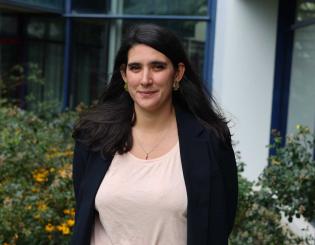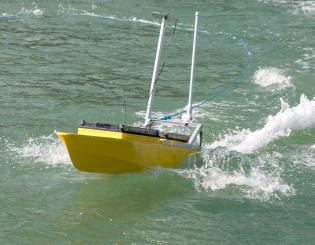
MATRIX team
The MATRIX team studies the formulation of the problem and its solution, by looking at different layers:
- Modeling
- Optimization tools and methods
- Problem-solving and study criteria
Expertise
- Signal and image processing
- Machine learning
- Automation and dynamic systems
- Optimization
- Statistical methods
- Reinforcement learning
- Underwater acoustics
Examples of topics studied
- Monitoring of the underwater environment (seabed, water column fluctuations)
- Optimization methods and reinforcement learning for the biomedical sector
- Robust AUV control with machine learning
- Smart positioning of sensors for radar communications
- Metrology of IT networks and outlier detection
- Mathematical models of resilience
Collaborations
Some examples of partners with which this research is conducted.
-
Companies: Naval Group, THALES, ECA Group, iXblue
-
Institutions: DGA, SHOM, NATO/CMRE, ONERA, CHU Brest
-
Academia: Flinders University, Centrale Nantes, UTT Troyes, University of Bath, Sorbonne Université, Queen Mary University of London, AUCE (Lebanon), Crossing (Australia, CNRS, Flinders University), LATIM (Brest), Université de Strasbourg, Qingdao University, MIT, Syracuse University, Polytechnique Montreal
MATRIX is working on the autonomous control of AUVs (autonomous underwater vehicles) operating in complex, heterogeneous underwater environments.
Gilles Le Chenadec, research professor: "AUVs need long-term autonomy and adaptation capacities, and we are meeting this need by developing methods combining the traditional concepts of automation with concepts based on AI and more particularly on deep reinforcement learning. This approach is aimed at associating the formal evidence of stability and reliability of automation with machine learning capacities. One of the cases of application being studied is that of an AUV operating in currents of variable intensity."
Six people from Naval Group, Flinders University and ENSTA Bretagne are delving into this subject in a number of theses:
- One thesis (Yoann Sola), defended in 2021 and financed by the French Defense, Procurement and Technology Agency (DGA) and the Brittany Region, demonstrated the merits under simulation of this approach compared to conventional approaches, with a reduction in energy consumption.
- A second thesis concerns adapting to marine currents the parameters of control theory learned by machine learning and the transfer of this model learned under simulation to an actual AUV.
- A third thesis is due to begin at the end of 2022, on the subject of AUV internal failure detection and control.
contact
Software/Hardware And unKnown EnviRonment Interactions (SHAKER) team
Methods
- (Joint) modeling of hardware and software architectures
- Design of dynamically adaptable Sw/Hw systems depending on the environment and application requirements
- Online verification of system behavior and temporal properties
- Implementation of tools for design, simulation and tracing.
Targets
- embedded system,
- system-on-chip,
- network of sensors,
- edge/cloud infrastructure.
Areas
- autonomous vehicles,
- critical systems,
- IoT,
- industry of the future,
- space,
- marine environment,
- home support
Collaborations
- Companies: ATOS, Orange, Naval Group, Thalès and DDN among others
- Institutions: CEA, b<>com Institute of Research & Technology (IRT), NIST (US) and Taiwan Academy of Sciences among others
- Laboratories: INRIA, IETR, LIRMM and LAMIH among others
- CNRS Research Groups: RSD, SOC2
Activities like mining exploration, port or coastal surveillance are increasingly carried out by swarms of drones controlled semi-automatically. The complexity of their networks makes them vulnerable to cyberattacks, however.
To secure the data contained and transmitted between drones, the ENSTA Bretagne/Lab-STICC Software/Hardware And unKnown EnviRonment Interactions (SHAKER) team launched the DISPEED* project with the AID in September 2022. Its goal? “To develop an intrusion detection system (IDS) factoring in the resources which each of the drones in the swarm needs in terms of energy and calculating capacity,” explains Camélia Slimani, a post-doctoral student at ENSTA Bretagne and a member of this team.
The most widespread IDSs leverage machine learning algorithms which require significant memory and computing power. Not all types of drones have the same processing capacities though (processors, memory, storage), which affects their cybersecurity performance. “The challenge is to come up with an execution model which strikes a relevant trade-off between swift detection and energy use depending on the criticality of the attack and state of the system and the mission,” the researcher clarified.
The research team initially conducted an energy use and performance study of several existing IDSs before drawing up an appropriate execution strategy for the missions chosen for a population of drones operating autonomously.
* Project “Détection d’Intrusion et compromis Sécurité / Performance / Energie, Etude pour les meutes de Drones” (“Intrusion Detection and Security / Performance / Energy tradeoff, a Study for Drone swarms”) financed by the Ministry for the Armed Forces Defense Innovation Agency (AID).
- Objective of this project: to develop methods and tools for modeling data access profiles in an efficient and non-intrusive manner then use the models established to develop strategies for optimizing the energy consumption of compute nodes during the data access stage.
- Financed by: Atos
- Led by: Jalil Boukhobza, research professor at ENSTA Bretagne/Lab-STICC (SHARP department, SHAKER team)
In performance terms, storage systems represent one of the most significant weak links in an IT system, particularly for applications which process large amounts of data such as in the field of high-performance computing (HPC).
The emergence of new storage technologies is an opportunity to reduce the performance gap between working memory and storage, as well as energy consumption.
These technologies are deployed at various levels:
- storage memory (e.g. 3DxPoint),
- its interface (e.g. NVMe),
- or its software management (e.g. object store).
These technologies imply significant growth in the complexity of storage management in order to meet the service quality requirements of applications.
Objective: outline a model and strategies for running intrusion detection systems embedded on drones equipped with heterogeneous architectures and striking a relevant compromise according to the attack criticality and state of the system and mission, between detection speed/energy consumption.
- Financed by: AID
- Partners: FORTH Greece, Naval Group, UBO
- Led by: Jalil Boukhobza, research professor at ENSTA Bretagne/Lab-STICC (SHARP department, SHAKER team)
The distributed operation of fleets of drones during missions makes them vulnerable to diverse attacks that it is crucial to detect. Embedded in these drones are hardware components (computing and storage) with heterogenous computing power and energy consumption for performing the various tasks necessary for their mission.
The project sets out to develop models, strategies and tools for optimizing the energy cost of intrusion detection on a fleet of drones or any other cooperative system with major energy or hardware capacity constraints. These systems operate in cooperation to accomplish a joint mission. The network load therefore varies enormously depending on the context of the mission, which means that the intrusion detection system does not need to be run continuously on equipment requiring significant hardware capacity or consuming a considerable share of the system’s energy.
The aim of the project is thus to study and analyze how the performance of the IDS can be adapted using various hardware components depending on this network load and the context of the mission.
4 challenges underpin the project:
- Challenge 1: modeling the execution environment
- Challenge 2: setting up an assessment platform
- Challenge 3: designing a configuration selection strategy based on multi-objective optimization tooling
- Challenge 4: implementing an inter-drone balancing/offset computing system for reducing energy consumption.
Objective: design effective data positioning systems on multi-tiered storage architectures in the field of high-performance computing.
- Financed by: CEA
- Led by: Jalil Boukhobza, research professor at ENSTA Bretagne/Lab-STICC (SHARP department, SHAKER team)
In performance terms, storage systems represent one of the most significant weak links in an IT system, particularly for applications which process large amounts of data. The emergence of new storage technologies is an opportunity to reduce the performance gap between working memory and storage. These technologies, deployed at the level of storage memory (e.g. 3DxPoint), its interface (e.g. NVMe) and even its software management (e.g. object store), imply significant growth in the complexity of storage management. In addition, amid the "big Data" boom, more and more applications are processing huge amounts of data, and present different levels of criticality.
Against this backdrop, we intend to study and come up with new data positioning strategies with different levels of criticality on heterogenous, geo-distributed storage systems. As part of this project, we will explore several techniques including machine learning, reinforcement learning and optimization methods, to guarantee effective online data positioning.
contact
Processes For Safe And Secure Software And Systems (P4S team)
Enhance the operating safety and security of digital systems: methodological strands
- System modeling to describe the needs of the system under study
- Modeling of construction processes and their improvement, which is critical for the safety, and security of and, more generally, confidence in, the system studied.
- Federation of models since varying viewpoints need to be merged.
- Free modeling to enable specific viewpoints to be developed, as no framework can encompass all viewpoints.
- Formal verification at all levels: intra-model and inter-model.
- As well as automated and semi-automated methods alike.
Expertise
- Model-driven engineering,
- Software engineering,
- Software verification
- Product lines
- (Self) adaptive systems
- Cognitive systems
- Requirements engineering
- Formal specification
- Diagnosis
- Executable semantics,
- Formal verification
- Debugging
Collaborations
- Companies: Airbus, Thales, PragmaDEV, Kereval, Davidson, Lucio-Zekat
- Institutions: DGA, CEA
- Academia: IRISA
- Research Groups: GPL, SOC2
Against a fiercely competitive global economic backdrop, the aeronautical industry is one of France’s strengths. With a fabric of small, medium and large companies, the French aeronautics sector is the only one, along with the United States, that is fully capable of developing, producing and marketing civil and military aircraft. The French Government has developed a plan for supporting the aeronautics sector, designed to protect French expertise and know-how, while delivering the far-reaching changes needed to achieve the energy transition. The strategy is focused on the green transition and lowering carbon emissions in air transport.
The French aeronautical industry’s expertise on its products, programs and interactions within its value chain is widely recognized. For all that, it must contend with a growing number of challenges if it is to become more proficient in its design and development cycles and more efficient in its engineering activities and ensure that the performances of its products and support systems continually improve. It also needs to take technological innovations more swiftly on board and take advantage of the opportunities offered by new information technologies. Given these challenges, there is an inevitable need for radical changes to engineering methods within the French aeronautical industry, and this is where the ONEWAY project comes in.
The project began in May 2021, for an 18-month period, with a budget of €48m. It brought together 14 partners: Airbus, Dassault Aviation, Liebherr Aerospace, Safran Electrical & Power, Safran Aerotechnics, Thales, Altran Technologies, Cap Gemini, Sopra Steria, CIMPA, PragmaDEV, IMT Mines Ales, Université de Rennes 1 and ENSTA Bretagne.
ENSTA Bretagne helped to define a digital capacity for supporting decisions regarding launch, then control and management of a Product Development Plan (PDP). The PDP seeks to predict and control the best date for a product and its industrial system to be brought to the market, as well as the expected production ramp-up stage. This has become crucial for the competitiveness of the French aeronautical industry.
Thanks to the experience of ENSTA Bretagne’s Processes for Safe and Secure Software and Systems (P4S) team on federating complex software systems, the development of formal semantics and analytical algorithms, an equipped PDP modeling framework has been established. The tool developed allows for a detailed capture of the business specifics, industrial-scale simulation of the development process and validation of the models built through formal verification methods.
For ENSTA Bretagne, the two main implications in the ONEWAY project concern the formal verification and validation of the PDP. Project outcomes:
- Extension of the OBP2 model-checker with statistical exploration algorithms for massive testing on industry-derived models;
- Improvement of the layer of expression of formal properties associated with the system requirements or Top Program Objectives;
- Invention of a modular strategy for the formal verification of time-bound systems, based on the PDP’s formal semantics without the need for costly model processing procedures.
- Cyber-security modelling and analysis framework" research project: Developing a cohesive framework for the specification, formalization and analysis of secure software and hardware architecture
- in progress since December 2020
funded by the AID (Defense Innovation Agency) - led by Raul Mazo Pena, a research professor at ENSTA Bretagne / Lab-STICC (SHARP department, P4S team)
To find out more: read the article on this program
It is still early days for the "Security by Design" approach and significant R&D efforts will be required for its use to become systematic and widespread. That’s the aim of this groundbreaking project, which is in some ways opening up a whole new engineering discipline by outlining a new vision. To take up this challenge, the project sets out to create a cohesive, overarching theory, with systematic design tools, techniques and methods.
- Project funded by the Brittany Region and FEDER
- started at the end of 2019 until 2022
- 3 partners: KEREVAL, Mobility Tech Green and ENSTA Bretagne
- led by: Joël Champeau, a research professor at ENSTA Bretagne, UMR (joint research unit) Lab-STICC (SHARP department, P4S team
The project sets out to develop products and services embedded in connected vehicles, as well as associated off-board services.
These on-board services will have gone through a secure development process.
ENSTA Bretagne’s contribution involves developing a design methodology and tooling of cybersecurity tests specially geared towards "connected vehicles".
This method will need to range from the system level, factoring in the security requirements, to the communication modules of the embedded calculator.
The expected results of the project are the development of such new mobility services as fleet management, development of a CyberLab to run the security tests of the services and a methodological support grounded in a formal verification of the security requirements.
...












